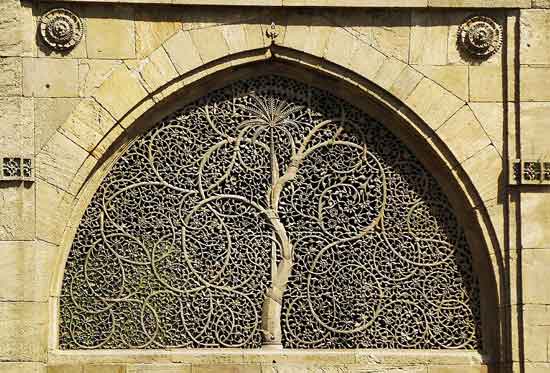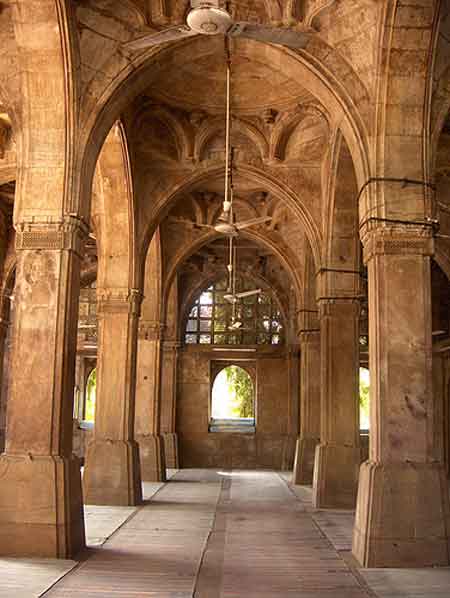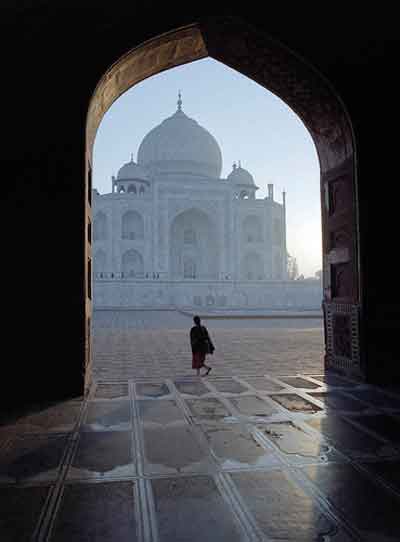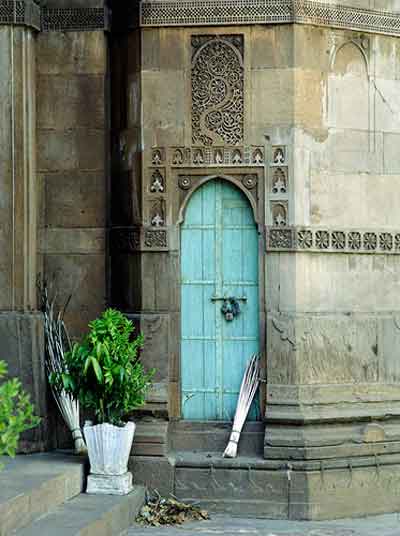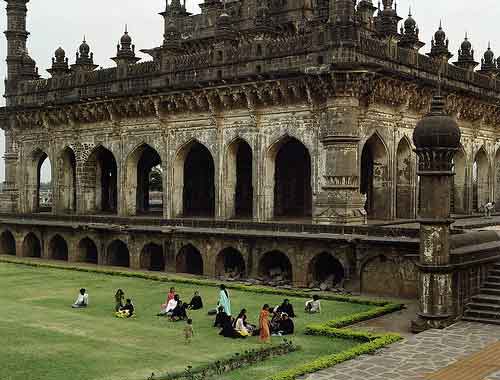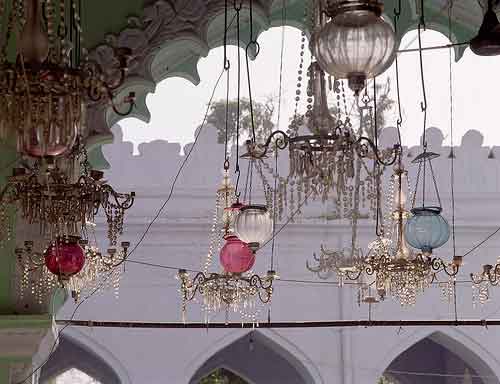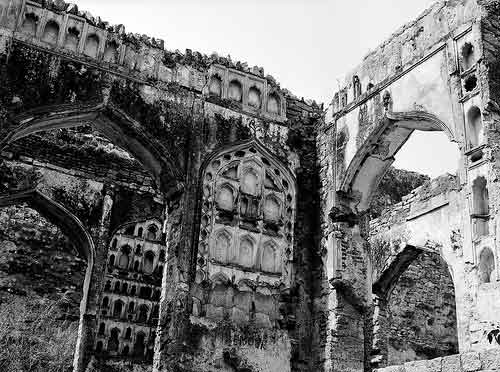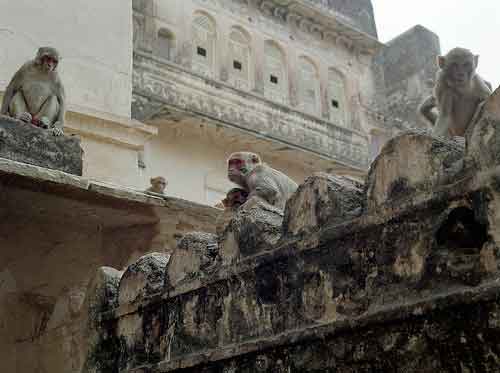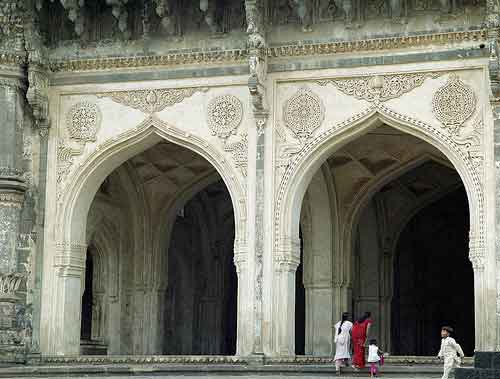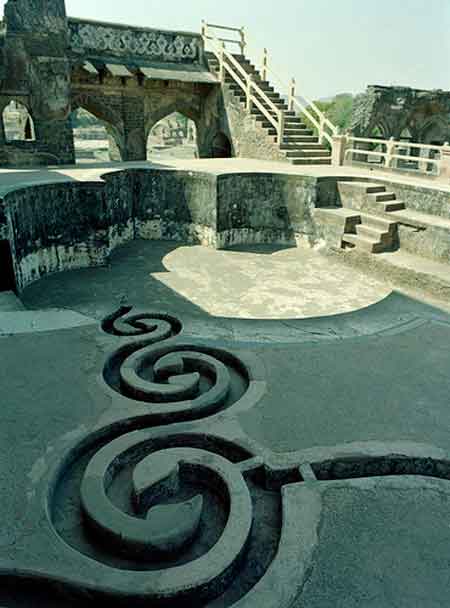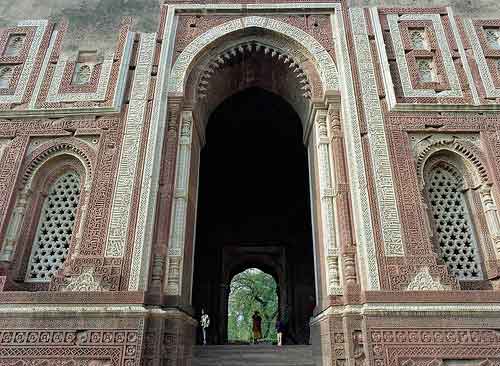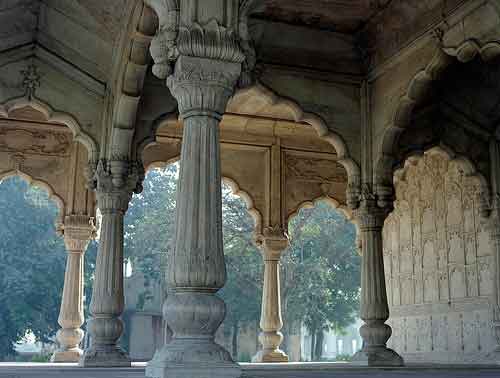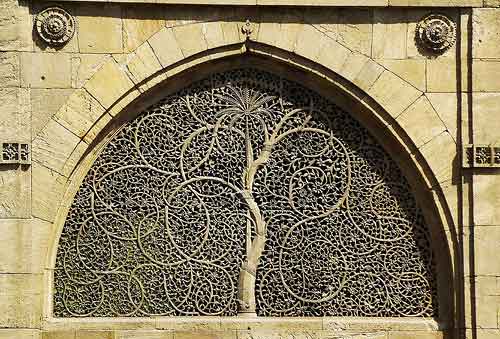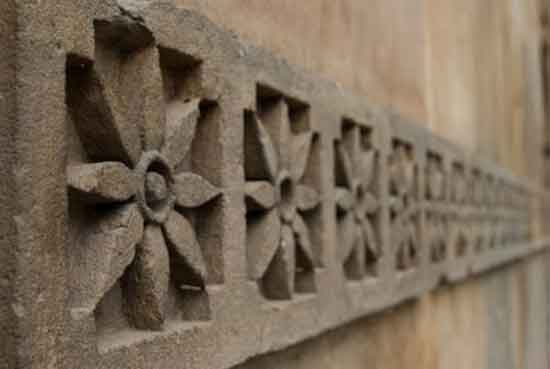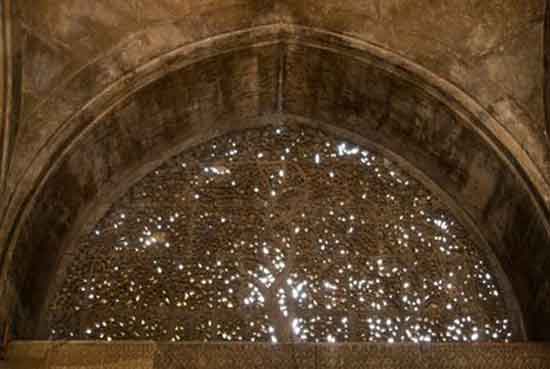Siddi Sayed's Mosque
Monday, 05 October 2009 09:48
Siddi Sayed's Mosque - Ahmedabad |
About: |
| The Sidi Saiyad Mosque is a renowned ancient mosque in Ahmedabad, built by Ahmed Shah's slave Sidi Saiyad in 1571. Situated near the famous Lal Darwaja at Bhadra, it was once part of the city wall of Ahmedabad. The most interesting features of the mosque are the fabulous Jhali screens lining its upper walls and the magnificent and exclusive stone tracery. The screens are framed in ten semi-circular windows and are built in Indo-Saracenic style of architecture. The carved stone windows depict the complex intertwining of the branches of the kalpa tree.
The mosque is entirely arched and has ten screen windows (jalis) on the side and rear arches. The twin windows of pierced stone are carved in style of a tree with palm leaves and curved tendrils. These screens are framed in ten semi-circular windows. This mosque is a superb and peerless example of delicate carving that transforms stone into filigree. The beautiful carved stone windows depict the intricate intertwining of the branches of a tree. This intricately carved stone window is called the Sidi Saiyyed Jali. Wooden models of these windows, which are a fine example of Indo-Sarcenic architecture, are kept in the New York and Kensington museums. The rear wall of the Sidi Sayiad’s Mosque Ahmedabad is filled with square stone pierced panels in geometrical designs. The two bays flanking the central aisle have reticulated stone slabs carved again in designs of intertwined trees and foliage of the Kalpa tree, a Hindu motif; a palm and parasite motif. This mosque was once part of the city wall, and is now close to the river end of Relief Rd. |
Location info: |
| Address:Sidi Sayiad’s Mosque ,Ahemadabad,India |
| District: Ahemadabad |
| Nearest City: Ahemadabad |
| Best time to visit: October and March. |
Climate/Weather: |
| Winter season is from has 20 degree C to 32,hot season 28 degree C to 42 |
History: |
| The Sidi Sayiad’s Mosque was built in 1573 by Sidi Saiyyed, a slave of Sultan Ahmed Shah. The mosque was built in the last year of the Sultanate of Gujarat and is now one of the most famous monuments in Ahmedabad. |
Interesting things to do: |
Interesting things to Visit: |
|
Bhadra Fort and Teen Darwaza: Mata Bhavani’s Well: Shaking Minarets: Dada Hari Vav: Sabarmati Ashram: Tomb of Ahmed Shah: Calico Museum: Kite Museum: City Museum: Shreyas Folk Museum: Hathee Singh Temple: Ahmed Shah’s Mosque: |
Mobile range info: |
How to reach? |
| Nearest Railway Station:Ahmedabad railway station |
| Nearest Airport:Ahmedabad airport |
| Road Transport:State of Gujarat, Maharashtra, Madhya Pradesh and Rajasthan provide regular bus services to Ahmedabad from all major centres in the area. |
Nearest Visiting places: |
| Swaminarayan Temple: The Swaminarayan temple is located in Kalupur in Ahmedabad. It is believed to be the first ever Swaminarayan temple to be built. The interiors and exteriors of the temple have been adorned with typical Gujarati designs and has beautifully decorated domes and galleries. There are lush green lawns outside the temple which accentuate its beauty. On the southern side of the Temple there are nine tombs which are popularly known as 'Nau Gaz Pir' or Nine Yard Saints..
ISKCON Temple: The temple has huge halls which are illuminated with grand looking chandeliers. The interiors are quite spacious and as regards the exteriors, the campus is filled with large number of flowering trees and plants. The temple has a peaceful and tranquil atmosphere and the devotees who come to the temple are supposed to maintain the silent and peaceful atmosphere of the temple premises. Prayer sessions are held here in the mornings and evenings. The prayer ceremonies are accompanied with chanting of religious songs called 'kirtans'. The temple hosts two main festivals- Janmashtami (birthday of Lord Krishna) and Nand Mahotsav (the day following Krishna's birthday). On Janmashtami Day, the entire temple is illuminated and lavishly decorated. 'Mangal Aarti' is held in the evening which is attended by a large number of people. Flowers, fruits, incense and sweets are offered to the deities on this day and there are discourses from the Bhagvad Gita- the holy book of the Hindus. Nand Mahotsav is celebrated the day after Janmashtami. On this day thousands of devotees throng the temple premises to offer their prayers. The temple arranges for lunch for the devotees on this auspicious occasion. Mahaveer Swami Temple: Gheekanta Shankeshwar Teerth: Sri Karnavati Teerth: Jagannath Temple: Param Dham: Manav Mandir: Sri Mahalakshmiji Temple: Vageshwari Mataji Temple: Jama MasjidJama Masjid: Rani Rupmati's Mosque: Rani Sipri's Mosque: Jhulta Minara: Ahmed Shah'Mosque: Raj Babri Mosque: Bai Harir Mosque: Bai Harir tomb is located on the north-eastern part of Bai Harir mosque. The entrance of the tomb faces towards the south. the mausoleum has a tomb chamber with a huge semi circular dome. This is surrounded by low corridors with four small domes. Plant sculptures and geometric patterns resembling Gujarati art decorate the basement of corridors and the bottom of the mausoleum. Bibi ki Masjid: Badshah-no-Hajiro: Roza of Shah Alam: Kutbi Mazar: |
Nearest Petrol Pump: |
| MMercury Petrol Pump:Ellisbridge,Ahmedabad,Gujrat,India
Panchavati Petrol Pump:Panchavati, Ahmedabad,Gujrat,India |
Hotels/Lodge/Accommodation: |
| Pride Hotel:Bodakdev,Ahmadabad,Gujarat,India
Fortune Hotel: Ashram Road ,Ahmedabad,Gujarat,India |
Things to carry: |
Tips & Suggestions: |
Help Line/Phone Number: |
| Police Station:100 |
| Nearest Hospital: Sterling hospital:Ahmedabad, Ahmedabad, Gujarat, SALHospital:Drive In, Ahmedabad, Gujarat
|
| Society/Community Phone Number: |
| Links:www.gujaratguideonline.com |
Video
Dynamic View
|
|
| Jumma Masjid |
| Jumma Masjid of Ahmedabad is one of the most beautiful mosques in India. It was built in the year 1423 by the founder of the city, Sultan Ahmed Shah, and is located in the old city. Built in yellow sandstone, this monument is capable of outshining any other monument of Ahmedabad. Jama Masjid is a fine example of Indo Saracenic architecture, with the special touch of the Sultan himself. It presents an extraordinary blend of Hindu and Muslim styles of architecture.The historians refer to it as the most beautiful mosque of the east. It is an imposing structure in the center of the old city and rests on 260 pillars, supporting fifteen domes....more |
| Sarangpur Hanumanji Temple |
| Hanumanji Maharaj at Sarangpur, is famed around the world for expelling spirits and Ghosts from people plagued with such problems. This was due to the blessing of Gopalanand Swami to Vagha Khachar, who invoked Hanumanji with his wand, to be ever present in the idol to drive out such evils. The kind Swami helped Vagha Khachar with such blessing as he readily served saints and devotees offering them hospitality. As a result his income had dwindled. Swami therefore decided to help him by installing the idol of Hanuman, which provided a strong source of income, which facilitated him to continue to render service to saints and devotees....more |
| Manav Mandir temple |
| Manav Mandir is a lotus shaped, pink temple erected by the Ashirvad society and is located at Cinema Road. It is also known as Kamal Mandir. The presiding deity of the temple is Mataji also known as Ambaji - the source of Shakti-Spiritual energy. Darshan is open to visitors from morning 6.00am to 12.30 noon and from 3.00pm to 9.30pm. The Arti timings are 7.00am and 7.00pm. During the Navaratri festival (September-October) special prayer programmes and yagna are performed.Manav Mandir is one of the famous temples in the district. It is a lotus-shaped, pink temple erected by the Ashirvad society. Dedicated to Mataji, the source of power or spiritual energy, the temple attracts more than 10,000 devotees a year. The temple is also famous as Kamal Mandir. A wide range of pujas are arranged in the temple.....more |
| Bhadra Fort and Teen Darwaza |
| One of the most beautiful monuments in Ahmedabad is the Bhadra Fort and Teen Darwaza, Ahmedabad. Situated in Ahmedabad this is one of the most beautiful forts in the city which attracts tourists from all over. Indianholiday.com offers online information on Bhadra Fort and Teen Darwaza, Ahmedabad and other tourist attractions of Gujarat and other parts of India.When it comes to monuments in Ahmedabad, Bhadra fort is one name that indeed deserves a special mention. Constructed in the year 1411 A.D. during the rule of Marathas, it was established by Sultan Ahmad Shah, the founder of Ahmedabad city. Bhadra fort in Ahmedabad is a royal fort that occupies the top most position in the Ahmedabad sightseeing tour. Read on to know more about Bhadra fort in Ahmedabad, India....more
|
| Mata Bhavani Well |
| Mata Bhavani Well is a step well located just 200 m north of Dada Hari Wav in Ahmedabad, Gujarat. Built in 11th century, this long well with the ends projecting east and west is noted for its fine carvings. It has an entrance on the east side. The staircase goes down to the east and at the east end, there is a circular shaft. The well was built in the form of stairs as the water level changes depending on seasons.Mata Bhavani Well, Ahmedabad is one of the important tourist attractions of Ahmedabad. The Mata Bhavani Well, Ahmedabad is one of the longest wells that ends projecting towards and east and west. On the eastern side there is an entrance. The staircase to the Mata Bhavani Well, Ahmedabad descends to the east end and there is a circular shaft. In the earlier times, water in the shaft was brought up by the cows and used for irrigation.....more |
| Tomb of Ahmed Shah |
| The tombs of Ahmed Shah and his queens are located outside of the east gate of the Jama Masjid to the south west of Bhadra Fort in Ahmedabad, Gujarat.It was constructed in 1442 after the death of Ahmed Shah, the founder of the city.Women are prohibited to visit the central chamber of the mosque. The tombs of the queens are situated on a raised platform across the street.The Tomb of Ahmed Shah Ahmedabad is one of the most important tourist attractions of Ahmedabad. The tomb is square shaped with latticed stone windows. The women are not allowed in the central chamber in the Tomb of Ahmed Shah Ahmedabad. Just across the main road is the Rani no Hajiro where you can get to see the tombs of Ahmed Shah queens. Though the Tomb of Ahmed Shah, Ahmedabad is in quite good shape yet the tombs of Ahmed Shah wives are not in quite good shape.....more |
| Sabasrmati Ashram |
| Sabarmati Ashram is situated on the banks of River Sabarmati. It was founded in the year 1917 AD and is also known as Gandhi Ashram or the Harijan Ashram. The ashram once served as the residence of the Father of the Nation. It is from this place that Gandhiji spearheaded the Dandi March, on 12th March 1930.The March was an important event in the freedom struggle of India. It was aimed at revolting against the salt laws imposed by the British Government. The ashram faces the prison on one side and the river on the other.Sabarmati Ashram, formerly known as Satyagraha Ashram, situated in Ahmedabad at the Kocharab Bungalow of Jivanlal Desai a barrister. Later on it was shifted to the banks of Sabarmati river and then it came to be known as Sabarmati Ashram. Gandhi stayed at the Ashram from 1915 to 1933 later on the Ashram was disbanded. The Ashram is a witness to many important historical events....more |
| Shaking Minarets |
| The Shaking Minarets, Ahmedabad or the Jhulta Minar is one of the most unique monuments in Ahmedabad. Located in Siddi Bashir Mosque near the Sarangpur gate this is one of the beautiful tourist places in the city. Indianholiday.com offers online information on Shaking Minarets Ahmedabad and other tourist attractions of Gujarat and other parts of India.The Shaking Minarets, Ahmedabad is one of the most interesting tourist attractions of Ahmedabad which you can see on your tour to Gujarat. Each of the minarets is 3 storeyed tall and they have intricate designs carved on them with stone balconies that are around 21.34 meters high. If any one of the minarets is shaken then the other minaret even vibrates. However the most surprising fact about the Shaking Minarets in Ahmedabad in India is their connecting passage which remains free of any kind of vibration. From intricate designs to the exquisite artwork the Shaking Minarets, Ahmedabad are one of the major tourist attractions in Gujrat.....more |
| Dada Hari Wav |
| Dada Hari Vav is an octagonal shaped well, which is located below the ground level. This underground well has been intricately carved in the typical Gujarati designs. Made from fine stone work of Gujarat, the well has been drawing more and more tourists year after year. While designing this stepped well, adequate attention was paid to its each and every detail. This is indicative from the fact that, right from pillars to walls to steps, everything has been beautifully decorated. The visiting hours of the well are from 09:00 am to 05:00 pm.The Dada Hari Vav, Ahmedabad is a uniquely designed octagonal shaped step well in Ahmedabad. The interiors and the underground of the Dada Hari Vav, Ahmedabad has been intricately designed. Each year tourists from all over are allured to visit this unique step well which is one of the major tourist attractions of Gujarat....more |
| Adalaj Vav |
| Adalaj Vav is a five-storied step-well located in a small sleepy village named Adalaj, about 15 km from Gandhinagar city. Adalaj Vav was built in 1499.There are about 120 vavs or step-wells spread across the Indian state of Gujarat. The oldest vav is the Rani vav or Queen's vav, which is located in Patan and dates back to the 11th century AD. However, the vav situated in the small village of Adlaj is the most popular one. The Adlaj vav is in fact a na vav, literally meaning an upside down architecture of a step-well.Built entirely of sandstone, one can enter into this step-well from three sides, which consist of octagonal landings with huge carved colonnades and intricately carved niches. The architecture of this well also shows the influence of the earlier Solanki rulers of Gujarat....more |
| Rani ki Vav |
| Rani Ki Vav is the oldest and the grandest stepwell in the state of Gujarat. It is situated at Patan and is believed to have been built during 1022 to 1063 AD. The construction was completed by the widowed queen Udayamati.She was the wife of King Bhimdev I son of Mularaja, the founder of the Solanki dynasty of Anahilwada Pattan.It is a richly sculptured monument and a major tourist spot in Patan. The size of the Rani Ki Vav is so huge that the tourists appear to be ants climbing an anthill.Due to silting, a major portion of the well has deteriorated. There were some renovation exercises in 1980, which have restored some of the ancient glory of the place. One of its pillars is so beautifully carved, that it reminds one of the ancient charm of the monument. It appears the well is made up of bricks. There is small gateway just below the last step of the Rani Ki Vav well. The gateway opens into a 30 km tunnel which leads to the nearby town of Siddhpur. This was used by the King to escape in the times of defeat.....more |
| Harappan Ruins |
| Lothal Harappan Ruins are by far the most important and significant tourist attractions of the place. One can take a stroll round the ancient dockyard, the bastion, the lower town, the bead factory and the storage houses. The advanced and modernized drainage system is something to marvel at. There is a museum right to the west that showcases a number of articles comprising of bronze and copper mirrors, painted potteries, miniature bullock carts used as toy items, jewelry, beads and a variety of objects made of stone, shell and bone. You can also take a close look at the seals from Bahrain, terracotta figures whose origin can be traced back to Sumeria and other objects from Egypt. Another interesting item on display is a model of the city made of plaster of Paris based on reconstructions made by archeologists....more |
| Shreyas Folk Museum |
| Sabarmati in the suburbs of Ambavadi is Shreyas Folk Art Museum. The Museum showcases the traditional folk art and crafts of Gujarat's numerous tribes. The museum is opened from 9 am to noon from 3-5 pm from Tuesday to Thursday.The museum exhibits the folk arts and crafts of Gujarat, particularly textile and clothing. Also on exhibit include a complete elephant skeleton (3.19 m high), coins, animal's caparisons, weapons, toys, costumes, masks, puppets and musical instruments.The city grew steadily outgrowing the space within the city walls, spreading further outward even to the other side of the river. Eventually, most of the walls were removed, and today only the gates still stand, as well as a short section of wall also stands along the riverfront.....more |
| Kite Museum |
| Kite Museum is at Paldi in Ahmedabad.January is the season for kites in Ahmedabad, as it is in the whole of Gujarat. During the festival of Makar Sankranti, which marks the end of winter solstice, the city skies become ablaze with colourful kites of all shapes and sizes. It is a little surprise then that Ahmedabad is home to a unique Kite Museum. A visit to this museum is an educative and entertaining experience for the children, one that will acquaint them with kites - how they are made and how they fly. Creative designs are bound to capture their imagination.Ahmedabad is in a hue of spectacular colours cutting across the blue skies as the International kite festival brings the most fantastic shades and designs. The kite festival is a cause for celebration across Gujrat. Friends, family and neighbourhood acquaintances are all out on the streets trying to outdo the other with some strategic moves to win and stay flying. And if the splendor of the day gets you all excited you should witness the beauty of the lit box kites in the nights....more |
| Lalbhai Dalpatbhai Museum |
| The Lalbhai Dalpatbhai Museum, Ahmedabad also known as the Institute of Indology has a strong collaboration with the National Mission from 2003. The list of manuscripts, books and miniature paintings gives the tourists an idea about the art and culture of ancient India. From painted patas, sculptures to bronze and woodwork, Lalbhai Dalpatbhai Museum, Ahmedabad is an educative and informative place for the tourists.The museum has a huge collection of miniature paintings, cloth paintings, stone sculptures, terracotta, bronzes, textiles, wood work, metal sculptures, coins and various paintings of Tagore and artwork of Nepal and Tibet. The museum has also a big library, which contains about 45000 books and 75, 000 manuscripts. The books are based on Jainism and Buddhism, tantra, grammar, and Indian philosophy. The books are written in different languages like Sanskrit, Pali, Prakrit, Old Gujarati, Apabhramsa, Hindi, and Rajasthan.....more |
| Archaeological Museum |
| Lothal a very ancient city lies about 87 kilometers from Ahmedabad,There was a full-fledged settlement in Lothal during the the Harappan era that dates back to the 2nd millennium BC. About 82 kilometers from Ahmedabad, you will get the opportunity to see the incredible sight of the world oldest urban cultures or Harappan culture in its fullest form.The museum was setup in 1976 in order to display the artifacts recovered from the excavation conducted from 1952 to 1961.The Museum has three galleries.In the front gallery depicts an artist conjectural idea of Harappan town of Lothal. There are also introductory write-ups and maps about the site. The gallery at left side has showcases with beads, terracotta ornaments, replicas of seal and sealings, shell and ivory objects, copper and bronze objects, tools and potteries yielded from excavations....more |
| City Museum |
| The City Museum, Ahmedabad is in the Sanskar Kendra building which is one of the finest museums in Ahmedabad. Located in the heart of the city, the building was built by the well known French architect Le Corbusier. The City Museum attracts tourists from all over. Indianholiday.com offers online information on City Museum, Ahmedabad and other tourist attractions of Gujarat and other parts of India.The tourists can also get a glimpse of ancient art, pottery, woodcraft and frescoes of medieval India in the City Museum, Ahmedabad. There are historical evidences of Industrial Revolution in Ahmedabad and the effects of Gandhism. Ahmedabad which was one of the most excellent textile producing regions was called the Manchester of India during that period. The City Museum, Ahmedabad also has remnants of that period stored in its precious memorabilia. Tourists can get a glimpse of exquisite designs on variety of textiles such as brocade, Chinese embroidery, carpets, tents, royal attire. There are some precious photographs as well as antique camera and other equipments....more |
| Calico Museum of Textiles |
| Calico Museum of Textiles is one of the finest museums to be set up in India. It was inaugurated in the year 1949 by the then Prime Minister of India, Jawahar Lal Nehru. The museum houses one of the rare collections of textiles, dating back to the 17th century. It is presently located in the Sarabhai Foundation, in the Shahibag premises. Calico museum is the world's best museum on textiles. Ahmedabad has been a major textile trade center sine the 15th century. This inspired Shri Sarabhai, his sister Gira Sarabhai and the great industrial house of Calico to establish India's unique museum on textiles in the city.The textiles on display include court textiles used by the Mughal and provincial rulers of 15th to 19th centuries. Also on display are regional embroideries of the 19th century, tie-dyed textiles and religious textiles. The galleries also have exhibits on ritual art and sculpture, temple hangings, miniature paintings, South Indian bronzes, Jain art and sculpture, and textile techniques galleries and a library. The museum has played an important role in determining the curriculum taught in the textile designing courses at the prestigious National Institute of Design also located in Ahmedabad....more |
| NC Mehta Gallery |
| N C Mehta Art Gallery is situated near the campus of Gujarat University in Gujarat. This art gallery houses an excellent collection of miniature paintings such as Pahadi miniatures and the famous Chaurpanchashika series.In all the Indian Museums the N.C.Mehta Collection of Gujarat Museum Society is very unique as It contains important collection of Pahadi Miniatures & the famous Chaurpanchashika Series, Chaurpanchasika Series is displayed at N.C.Mehta gallery only across the worldThe Gujarat Museum Society The main objective of the society are to preserve the invaluable collection of paintings, inculcate art appreciation and to promote its study and research. Indian miniatures include illustrations of sacred and secular works, poetic compositions, epics Ragamala paintings, Darbar scenes, portraits and social scenes....more |
| Nal Sarovar Bird Sanctuary |
| A black tailed godwit gracefully descends upon the tranquil water, flutters its wings and sails on. A small, brown and white wader with a slightly up curved bill, the bird has traveled 3500 kms from its nesting ground in Central Europe to spend the winter at Nalsarovar in Gujarat.Clouds upon clouds of more than 200 types of birds land in this lake having made an equally long journey to escape the harsh winter of their nesting areas. Here they find food and warmth. These migrant birds visit Nalsarovar every year from November to February. During these four months water is plentiful and fish, insects and aquatic plants abound in the lake an ideal environment for the birds. Nalsarovar at this time is a birdwatcher's delight....more |
| Law garden |
| Law Garden is a public garden in the city of Ahmedabad, India. The market outside the garden is very famous for the handicraft goods sold by local people. The road at the side of the garden is filled with street hawkers selling all kinds of food items.The Law Garden eatery market would be regularized. The standing committee has asked the municipal commissioner to get the design and policy prepared. The regularization will help generate employment and will help the civic body to keep a close watch on the quality of food served there.The most popular hub in the city of Ahmedabad is the Law Garden. This public garden is situated in the centre of the town of Ahmedabad.The familiar Law Garden is well known for purchasing the handcrafts and traditional Gujarati dresses from local vendors. Visiting this public garden will make you to rejoice and make a good pass time here....more |
| Sabrmati River |
| The Sabarmati River originates from the ranges of Arravalli in the Udaipur district of Rajasthan, Western India. The river is about 371 km in length. In its initial course, the river is also called as Wakal. The river empties into the Gulf of Cambay of Arabian Sea. The river traverses a stretch of about 400 Km. The Banas basin lies to the east of the river, while the Mahi Basin lie to its north, and the Luni Basin to its west. The southern boundary of the river flows along the border of the Gujarat State. The total area of the Basin is 4,164 km square.The course of River Sabarmati extends for almost 371 km in western India. The Sabarmati River starts its journey in the Aravalli Range of the Udaipur District of Rajasthan....more |
| Sarkhej Fair |
| A visit to Tourism of Gujarat offers information about the land of color and gaiety that Gujarat is situated in India. Tourism of Gujarat, offers information about the Sarkhej fair which is an annual event held in Gujaratin India. Sarkhej Fair, being held every year in Gujarat, India, witnesses a conglomeration of a large number of people from various parts of the state of Gujarat, situated in India.Tourism of Gujarat, takes a tourist on an odyssey across the confines of Gujarat, situated in India with the Sarkhej fair, being one of the most popular and the most significant Muslim fair in the region. Sarkhej Fair is held in the southern outskirts of the city of Ahmedabad, located in Gujarat, India....more |
| Tribal Museum |
| ....more |
